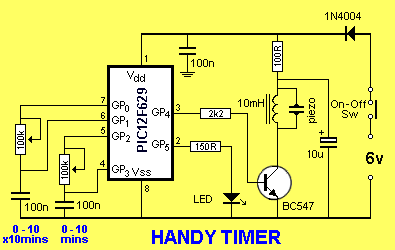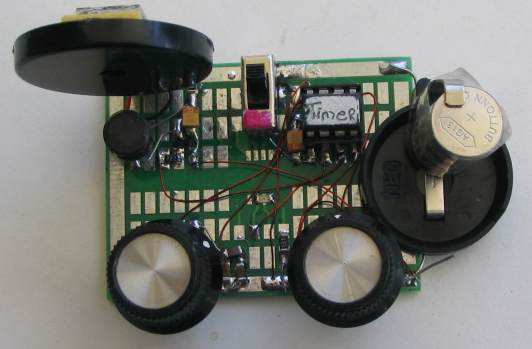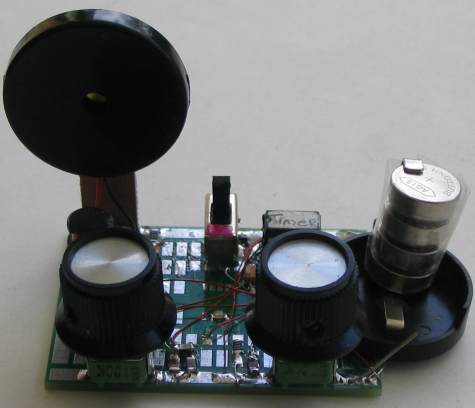|
|
|
|
This project will save you burning your food.
It will remind you to re-call a customer
and it will tell you when a TV program is about to start.
These are the sort of
things the timer can be used for.
Just turn the dials to the required time and turn the project ON.
When the dials are turned to "0" "0" the LED
will flash but the timer will not beep.
This project replaces an electronic timer bought some 15 years ago. It used
a CD4541 chip with 24 timing resistors on two 12 position rotary switches
and numerous other components to produce the beep.
But the electros went leaky and 20 minutes extended to 35 and 1 hour on
the timer
never produced a beep.
So this timer was born.

The timing is determined by the oscillator in the micro
and this is fairly accurate and reliable over a wide temperature range.
It is certainly better than external timing capacitors.
The only problem with the project is detecting the position of the wiper
on the two pots.
The ability to detect 10 locations on a pot is governed by the
accuracy of the 100n capacitor and the value of the pot.
The capacitors in our prototype had a 5%-10% accuracy but the pot had a 20% accuracy.
Some 100k pots were 80k and others 91k.
When this is combined, we get a wide variation.
That's why we had to allow for an adjustment.
We have specially made the timing so that you need to add a value across
the 100n capacitors to get 9 beeps when the pots are turned to 9
0'clock. Extra 10n and 47n capacitors are included in the kit. You can
connect two 47n in series to get an added 23n or put 10n across a 100n.
One of our pots was 81k and the 100n was 102n. This needed 2 x 47n in series
across the 100n.
The other was 91k and 107n and needed 10n in parallel across the 100n.
It is very difficult lowering the 100n so this is the best option.
Once the pot corresponds to the numbers on a clock, the rest of the
timing is done by the chip and uses a 1 minute routine that is called
a number of times.
The LED is illuminated for a very short period of time during approx
each second and this is done within the 1 minute routine. The frequency of 3860Hz for
the piezo was determined by using our Square Wave Oscillator project and
turning the pot until the output was the highest. The frequency was then detected
on a frequency meter and used in this project to get
the best output.
The 10mH choke increases the output considerably as it provides the
piezo with a very high waveform. The piezo is actually a 22n capacitor
and when combined with the 10mH inductor, the two work as a resonant
circuit to produce the high waveform.
The 100R, and 10u electrolytic across the piezo section of the circuit,
prevent spikes and dips in the supply caused by the low impedance of the
10mH choke from upsetting the micro.
The project takes approx 2mA during operation but considerably more
during the beep.


|
INSTRUCTIONS FOR
USE The first dial indicates the number of "minutes x10" and the numbers 10, 20, 30, 40 - - - - 90 are in the same locations as on the face of a clock. The second dial indicates the number of "minutes x1" with the numbers 1, 2, 3, 4, 5 . . .8, 9 in the same places as the numbers on a clock. Turn the first dial to the number of minutes x10 and you can add extra minutes by turning the second dial. Turn the dials and then turn the project ON. You will see the LED flash then produce beeps according to the number of "x10 minutes" detected by the circuit. If you have only selected the number of minutes x1 the beeps will let you know the number detected by the circuit. The LED will continue to flash approx every second to show the timer is working and the piezo will beep when the time has expired. If the timer squeals, the battery is flat. |
CONSTRUCTION
GOING
FURTHER
Handy Timer
13/10/10
You can build the circuit on any
type of Proto board. We have chosen our surface-mount board as it makes
a neat project and you can see all the wiring at the same time.
Use 4 button cells in a holder as the circuit requires very little
current and they will last a long time.
The
PROGRAM
This project is part of a course in PIC Programming. See left
index on Talking Electronics website: List of PIC
Projects: for the projects in this course.
The course consists of
building these projects and modifying the programs to learn the art of
programming PIC microcontrollers.
Most of the projects are very simple however they cover many different
routines and enable you to build up your knowledge.
This project has been produced on our standard template and contains a
number of sub-routines taken from other projects.
The hardest part of any program is interfacing it with the outside
world. One of these problems is to get accurate positioning of the pots.
To do this we
produced a sub-routine that created a value from a loop counter. We then adjusted the interval between each "look
to see when the 100n was charged" and when the loop counter was 10 for
the 10 o'clock position, it was complete.
The 1 minute delay could be determined mathematically by counting the
microseconds in the program but it was much easier to use a stop watch.
Finally, the LED was turned on for only 5mS per 800mS in the 1 minute
delay. This is less than 1% but the flash appears to be a lot longer due
to the Persistence of Vision of the eye.
The program contains a number a new subroutine that you
will be able to "cut and paste" for projects in the future.
If you want to modify the program you will need a programmer, a board to
hold the 8 pin chip during programming and an adapter to connect between
the programmer and PC board.
These are
covered in our article "Pick-A-PIC."
Here are the files you will need for "burning" your chip and/or
modifying the program:
Timer.asm
Timer.txt
Timer.hex
The following program is for viewing. It may contain
spaces or hidden characters that will not compile correctly to produce a
.hex file. Use the .hex file above to burn your chip or the .asm file to
modify the program.
;*******************************
;Handy Timer.asm
;13-10-2010
;*******************************
list p=12F629
radix dec
include "p12f629.inc"
errorlevel -302 ; Don't complain about BANK 1 Registers
__CONFIG _MCLRE_OFF & _CP_OFF
& _WDT_OFF & _INTRC_OSC_NOCLKOUT ;Internal osc.
;_MCLRE_OFF - master clear must be off for gp3 to be input pin
;****************************************************************
; variables - names and files
;****************************************************************
temp1 equ 20h ;
temp2 equ 21h ;
temp3 equ 22h ;
temp4 equ 23h ;
_beepA equ 24h ;for beep tone
_beepB equ 25h ;for beep tone
_flash equ 26h ;for flashing the LED
_potA equ 27h ;holds value 1-10 for x10minutes
_potB equ 28h ;holds value 1-10 for minutes
_loops equ 29h ;
temp equ 2Ah ;
del_x equ 2Bh ;
del_y equ 2Ch ;
xmin_1 equ 2Dh ;
xmin_2 equ 2Eh ;
xmin_3 equ 2Fh ;
temp_10 equ 30h
;****************************************************************
;Equates
;****************************************************************
status equ 0x03
rp1 equ 0x06
rp0 equ 0x05
GPIO equ 0x05
status equ 03h
option_reg equ 81h
; bits on GPIO
pin7 equ 0 ;GP0 out for x10mins
pin6 equ 1 ;GP1 in for x10mins
pin5 equ 2 ;GP2 out for mins
pin4 equ 3 ;GP3 in for mins
pin3 equ 4 ;GP4 piezo
pin2 equ 5 ;GP5 LED
;bits
rp0 equ 5 ;bit 5 of the status register
;****************************************************************
;Beginning of program
;****************************************************************
org 0x00
nop
nop
nop
nop
nop
SetUp bsf status, rp0 ;Bank 1
movlw b'11001010' ;Set TRIS GP0,2,4,5 out GP1,3,input
movwf TRISIO ;
bcf status, rp0 ;bank 0
movlw 07h ;turn off Comparator ports
movwf CMCON ;must be placed in bank 0
call flash
clrf GPIO ;Clear GPIO of junk
goto Main
;****************************************************************
;* Sub Routines and delays *
;****************************************************************
;approx 150uS delay for loops for potA and PotB
_150uS movlw .67
movwf temp1
_150u nop
decfsz temp1,f
goto _150u
retlw 00
_20mS movlw .20
movwf temp2
_20 nop
decfsz temp1,f
goto _20
decfsz temp2,f
goto _20
retlw 00
_500mS movlw 0FFh
movwf temp2
_500 goto $+1
goto $+1
decfsz temp1,f
goto _500
decfsz temp2,f
goto _500
retlw 00
_x1beep movlw 80h
movwf del_y
movlw .45
movwf del_x
nop
decfsz del_x,1
goto $-2
movlw b'00010000'
xorwf gpio,1 ;toggle GP4
decfsz del_y,1
goto $-8
call _500mS
call _500mS
retlw 00
beep movlw 0ffh
movwf del_y
movlw .45
movwf del_x
nop
decfsz del_x,1
goto $-2
movlw b'00010000'
xorwf gpio,1 ;toggle GP4
decfsz del_y,1
goto $-8
call _500mS
call _500mS
retlw 00
longbeep
movlw 0ffh
movwf del_y
movlw 0ffh
movwf del_x
nop
decfsz del_x,1
goto $-2
movlw b'00010000'
xorwf gpio,1 ;toggle GP4
decfsz del_y,1
goto $-8
call _500mS
retlw 00
;flash LED at start-up
flash movlw 0ffh
movwf _flash
bsf gpio,5
nop
decfsz _flash,1
goto $-2
bcf gpio,5
retlw 00
;potA = x10minutes
;Detects position of potA
; _potA will have 0-9
potA clrf _potA
clrf temp
bcf gpio,0 ;to discharge 100n
call _20mS
call _20mS
bsf gpio,0 ;to charge 100n
call _150uS
btfsc gpio,1
retlw 00 ;_potA & temp exits with 0-9
incf _potA,1
incf temp,1
goto $-5
potB clrf _potB
clrf temp
bcf gpio,2 ;to discharge 100n
call _20mS
call _20mS
bsf gpio,2 ;to charge 100n
call _150uS
btfsc gpio,3
retlw 00 ;_potB & temp exits with 0-9
incf _potB,3
incf temp,1
goto $-5
;x1min - 1 minute delay
x1min movlw .78
movwf xmin_3
_1min goto $+1
goto $+1
goto $+1
goto $+1
decfsz xmin_1,f
goto _1min
decfsz xmin_2,f
goto $+2
goto $+3
bcf gpio,5 ;give the LED illumination-time
goto _1min
decfsz xmin_3,f
goto $+2
retlw 00
bsf gpio,5 ;flash LED
goto $+1
goto $+1
goto $+1
goto $+1
goto _1min
x10mins movlw .10
movwf temp_10
call x1min
decfsz temp_10,1
goto $-2
retlw 00
;****************************************************************
;* Main *
;****************************************************************
Main call potA ;returns with value in _potA and temp
movlw 00h
xorwf temp,0
btfsc status,2 ;temp=00=zero "x10minutes"
goto min_only
call longbeep ;long beep to indicate x10minutes
decfsz temp,1
goto $-2
;temp destroyed
;only _potA 1-9 will be used
call x10mins
decfsz _potA,1
goto $-2
;check for x1min set on potB
call potB
movlw 00h
xorwf temp,0
btfsc status,2 ;temp=00=zero minutes
goto $+4 ; no setting on pot
call x1min
decfsz _potB,1
goto $-2
call beep
goto $-1
min_only
call potB
movlw 00h
xorwf temp,0
btfsc status,2 ;temp=00=zero "x10minutes"
goto Main ; no sound as no setting on pots
call _x1beep ;x1_beep to indicate x1minutes
decfsz temp,1
goto $-2
;temp destroyed
;only _potB 1-9 will be used
call x1min
decfsz _potB,1
goto $-2
call beep
goto $-1
END
You can add additional features to this
project by writing your own program or modifying the program above. Send any additions to Talking
Electronics for inclusion in this article.
Parts List
Cost:
au$20.00
plus postage
Kits
are available
1 -
150R SM
resistor
1 -
100R SM
resistor
1 -
2k2 SM
resistor
2 - 100k pots
3 - 100n SM capacitors
2 - 10n SM capacitors
(for adjusting 100n)
2 - 47n SM capacitors
(for adjusting 100n)
1 - 10u SM electrolytic
1 - SM red LED
1 - SM diode
1 - BC847 SM transistor
1 - SPDT mini slide switch
1 - 10mH choke
1 - piezo diaphragm
1 - 8 pin IC socket
2 - knobs for pots
20cm fine enamelled wire
20cm - very fine solder
1 - PIC12F629 chip (with
Timer routine)
1 - battery holder
4 -
button cells
1 - 3cm x 1cm blank PCB for piezo
1 - piece double-sided tape
1 - Prototype PC board
